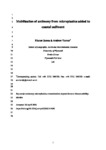Mobilisation of antimony from microplastics added to coastal sediment
| dc.contributor.author | James, E | |
| dc.contributor.author | Turner, Andrew | |
| dc.date.accessioned | 2020-06-10T11:02:54Z | |
| dc.date.issued | 2020-09 | |
| dc.identifier.issn | 0269-7491 | |
| dc.identifier.issn | 1873-6424 | |
| dc.identifier.other | 114696 | |
| dc.identifier.uri | http://hdl.handle.net/10026.1/15744 | |
| dc.description | 12 months embargo applies. | |
| dc.description.abstract |
Antimony (Sb) widely occurs in plastics as a pigment and reaction residue and through the use and recycling of electronic material enriched in Sb as a flame retardant synergist. In this study, clean estuarine sediment has been contaminated by different microplastics prepared from pre-characterised samples of different types of plastic (including a rubber) containing a range of Sb concentrations (256-47,600 μg g-1). Sediment-plastic mixtures in a mass ratio of 100:1 were subject to 6-h extractions in seawater and in seawater solutions of a protein (bovine serum albumin; BSA) and a surfactant (taurocholic acid; TA) that mimic the digestive conditions of coastal deposit-feeding invertebrates. Most time-courses for Sb mobilisation could be defined by a second-order diffusion equation, with rate constants ranging from 44.6 to 0.0216 (μg g-1)-1 min-1. Bioaccessibilities, defined as maximum extractable concentrations throughout each time course relative to total Sb content, ranged from <0.01% for a polycarbonate impregnated with Sb as a synergist exposed to all solutions, to >1% for acrylonitrile butadiene styrene containing a Sb-based colour pigment exposed to solutions of BSA and TA and recycled industrial polyethylene exposed to BSA solution. The potential for Sb to bioaccumulate or elicit a toxic effect is unknown but it is predicted that communities of deposit-feeders could mobilise significant quantities of Sb in sediment contaminated by microplastics through bioturbation and digestion. | |
| dc.format.extent | 114696-114696 | |
| dc.format.medium | Print-Electronic | |
| dc.language | en | |
| dc.language.iso | en | |
| dc.publisher | Elsevier BV | |
| dc.subject | Antimony | |
| dc.subject | Microplastics | |
| dc.subject | Contamination | |
| dc.subject | Deposit-feeders | |
| dc.subject | Bioaccessibility | |
| dc.subject | Kinetics | |
| dc.title | Mobilisation of antimony from microplastics added to coastal sediment | |
| dc.type | journal-article | |
| dc.type | Journal Article | |
| plymouth.author-url | https://www.webofscience.com/api/gateway?GWVersion=2&SrcApp=PARTNER_APP&SrcAuth=LinksAMR&KeyUT=WOS:000540263400051&DestLinkType=FullRecord&DestApp=ALL_WOS&UsrCustomerID=11bb513d99f797142bcfeffcc58ea008 | |
| plymouth.volume | 264 | |
| plymouth.publication-status | Published | |
| plymouth.journal | Environmental Pollution | |
| dc.identifier.doi | 10.1016/j.envpol.2020.114696 | |
| plymouth.organisational-group | /Plymouth | |
| plymouth.organisational-group | /Plymouth/Faculty of Science and Engineering | |
| plymouth.organisational-group | /Plymouth/Faculty of Science and Engineering/School of Geography, Earth and Environmental Sciences | |
| plymouth.organisational-group | /Plymouth/REF 2021 Researchers by UoA | |
| plymouth.organisational-group | /Plymouth/REF 2021 Researchers by UoA/UoA07 Earth Systems and Environmental Sciences | |
| plymouth.organisational-group | /Plymouth/Research Groups | |
| plymouth.organisational-group | /Plymouth/Research Groups/BEACh | |
| plymouth.organisational-group | /Plymouth/Research Groups/Marine Institute | |
| plymouth.organisational-group | /Plymouth/Users by role | |
| plymouth.organisational-group | /Plymouth/Users by role/Academics | |
| dc.publisher.place | England | |
| dcterms.dateAccepted | 2020-04-28 | |
| dc.rights.embargodate | 2021-5-1 | |
| dc.identifier.eissn | 1873-6424 | |
| dc.rights.embargoperiod | Not known | |
| rioxxterms.versionofrecord | 10.1016/j.envpol.2020.114696 | |
| rioxxterms.licenseref.uri | http://www.rioxx.net/licenses/all-rights-reserved | |
| rioxxterms.licenseref.startdate | 2020-09 | |
| rioxxterms.type | Journal Article/Review |


